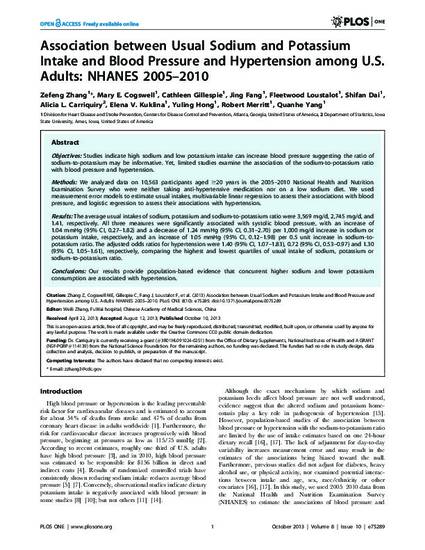
Objectives: Studies indicate high sodium and low potassium intake can increase blood pressure suggesting the ratio of sodium-to-potassium may be informative. Yet, limited studies examine the association of the sodium-to-potassium ratio with blood pressure and hypertension. Methods: We analyzed data on 10,563 participants aged $20 years in the 2005–2010 National Health and Nutrition Examination Survey who were neither taking anti-hypertensive medication nor on a low sodium diet. We used measurement error models to estimate usual intakes, multivariable linear regression to assess their associations with blood pressure, and logistic regression to assess their associations with hypertension. Results: The average usual intakes of sodium, potassium and sodium-to-potassium ratio were 3,569 mg/d, 2,745 mg/d, and 1.41, respectively. All three measures were significantly associated with systolic blood pressure, with an increase of 1.04 mmHg (95% CI, 0.27–1.82) and a decrease of 1.24 mmHg (95% CI, 0.31–2.70) per 1,000 mg/d increase in sodium or potassium intake, respectively, and an increase of 1.05 mmHg (95% CI, 0.12–1.98) per 0.5 unit increase in sodium-topotassium ratio. The adjusted odds ratios for hypertension were 1.40 (95% CI, 1.07–1.83), 0.72 (95% CI, 0.53–0.97) and 1.30 (95% CI, 1.05–1.61), respectively, comparing the highest and lowest quartiles of usual intake of sodium, potassium or sodium-to-potassium ratio. Conclusions: Our results provide population-based evidence that concurrent higher sodium and lower potassium consumption are associated with hypertension.
Available at: http://works.bepress.com/alicia_carriquiry/26/

This article is from PLoS ONE 8 (2013): e75289, doi: 10.1371/journal.pone.0075289.